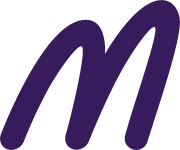Understanding Shopify SEO Optimization and How It Benefits Your Shopify Store
You’ve set up your Shopify store. You’re open for business. Now, you just need customers. There are many ways to attract customers to your Shopify website. Where should you start?
One of the easiest ways to attract new customers today is to improve your on-site SEO.
But what even is SEO? A question I’ve been asked many times. I’ve worked with thousands of small businesses who felt confused, intimidated, and uncertain about what SEO is.
Search Engine Optimization, or SEO, is the set of tactics used to increase the number of visitors to your website by obtaining a high-ranking placement on search engines like Google. SEO is fairly complex and can demand a lot time, energy, and money from business owners.
Merchants who use Shopify will enjoy a range of built-in SEO features that Shopify provides. These features are meant to simplify the optimization process, making it easier for stores to get found and to take the complexity of SEO off store owners’ shoulders.
However, sometimes these basic features aren’t quite enough. Although Shopify builds the foundation of SEO for your store, there are some simple things you can do to improve your website’s visibility and rank higher on search engines. This is what Shopify SEO Optimization is all about.
In this article, I’ll explain Shopify SEO Optimization, what methods exist to improve it, and outline the easiest way to make positive changes today.
This is the first step in our Guide to Shopify SEO Optimization. By the end of it, you’ll have mastered the basics. You will be ready to move on to the next step: finding a solution on how to improve your Shopify SEO Optimization.
What is Shopify SEO optimization?
Shopify SEO optimization is a search engine optimization strategy tailored specifically for Shopify-based online stores. This includes tactics and best practices for website elements unique to Shoipfy such as product pages, collections, and integrated apps.
When you set up a new store on Shopify, you will get some basic SEO features to start on the right foot. When anyone googles the name of your store, they should be able to find you.
Some of the basic features Shopify provides for SEO are automated, and these automated features can sometimes create issues that hinder your website’s performance.
For example, Shopify will automatically create meta titles for the pages on your website, but these titles are not always the best. They might not be descriptive enough or they might not have enough of the keywords you want to target.
Other examples of Shopify’s automated features for SEO include sitemaps, meta descriptions and pagination for products and collections.
Shopify has features that allow you to manually edit some elements of SEO optimization, such as meta titles and meta descriptions. But most merchants aren’t sure how to effectively use these features to optimize their store’s SEO.
With all of these issues, your website starts to fall behind in rankings. That’s why it’s important for all stores to assess their Shopify SEO, make improvements, and safeguard for the future.
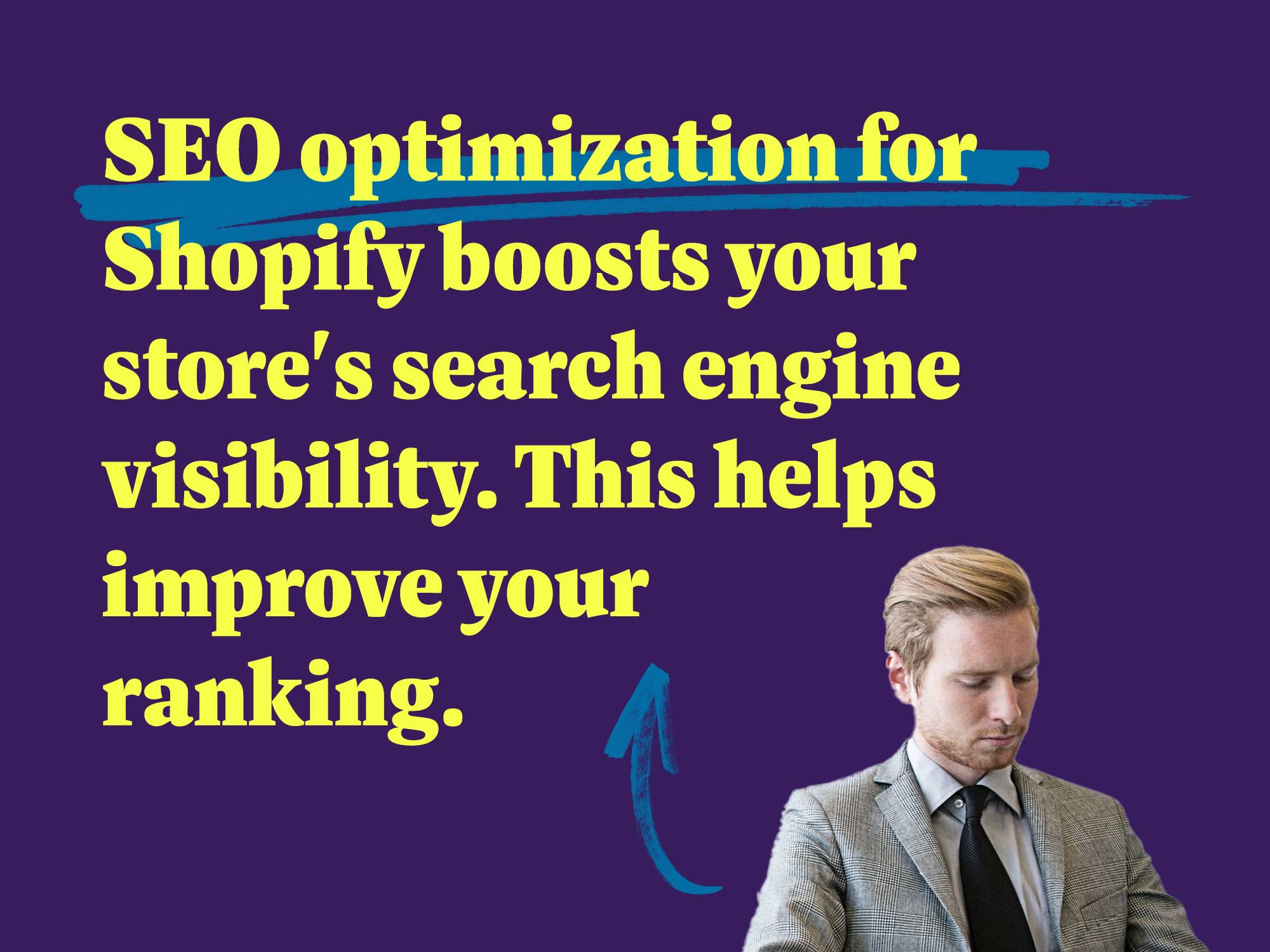
What types of SEO optimization methods exist?
There are many methods to SEO, and they usually fall into one of two general categories: on-site SEO and off-site SEO.
On-site Search Engine Optimization is concerned with optimizing the pages of your website, including the content of your web pages and the HTML source code.
In contrast, off-site Search Engine Optimization refers to activities outside of your website, focusing on other websites or social media platforms to improve your website’s rankings.
On-site SEO lays the foundation for your website, whereas off-site SEO takes this is a step further and boosts your website’s visibility and credibility across the web. Both are critical, but it’s usually better to prioritize on-site SEO first before focusing on off-site strategies.
Now that we have that covered, we can explore what types of methods exist for both on-site and off-site SEO:
On-Site SEO
Content
Maybe you’ve heard the phrase “Content is King”, a common marketing phrase originating from Bill Gates in 1996. What he meant is that high-quality, relevant content plays such a large role in attracting and retaining users on the internet. Almost three decades later, it still holds true.
What makes good content good? Relevance. Depth. It’s thorough, readable, organized, unique, trustworthy, and aligns with what users expect to read when they visit a page on your website.
Title Tag
You’ll recognize a title tag as the blue, clickable text on Google’s search results page (SERP). This is an HTML element that is meant to be an accurate description of the pages content. They help search engines understand the content on the page and are also important for user experience and sharing content.
Meta Description
You’ll recognize this as the grey text below the blue, clickable link on Google’s SERP. It is meant to provide additional context about the web page to both search engines and users.
Header Tag
Header tags are separate headings and subheadings on a webpage which are prioritized numerically – H1, H2, H3, H4, H5, and H6.
The article you’re reading right now is using them: “What is Shopify SEO Optimization?” is the H1 and the remaining headings are H2 and H3.
Headings help organize your content and make it more readable. Heading tags are important for SEO because they provide structure, improve user experience, and help search engines understand the hierarchy and relevance of the content.
Keyword Optimization
Keywords are the words that define your content. They are the words and phrases that the average person would google when they are looking for products and services like yours.
Keyword optimization involves the research and practice of using the best keywords for your product and services.
URL Structure
A URL is a web address that indicates where a website and its pages reside on the web.
URL structure plays a part in SEO, too. The ending of a URL (also known as a path or slug) can be customized. It is generally a good idea to make sure this is relevant, concise, readable, free of special characters, and all lowercase letters.
Image Optimization
Image optimization involves methods used to make your images easier for users and search engines to find. Using alt text, descriptive file names, and proper image formatting is a part of this strategy.
Alt Text
Alt text is used to describe images. It helps search engines understand the images. It also is read by screen readers which might be used by people who are visually impaired.
Internal Links
Internal links are hyperlinks naturally weaved in your content that bring users to other pages on your website.
This help users navigate your website by improving user experience. It also spreads the SEO value of one page to other various pages on your website.

Off-Site SEO
Local SEO
Local SEO refers to strategies for attracting customers searching for products and services in your local area. It focuses on improving visibility in local search results to drive traffic and engagement from nearby customers.
Link Building
Link building, or acquiring backlinks, are hyperlinks from other websites to yours. This linking is an important indicator to search engines that your website is credible.
Backlinks from high-authority, relevant websites are more valuable than those from lower-quality sites.
Social Media
Social media as part of an off-site SEO strategy involves driving traffic to your website from your social media profiles. This includes linking your profiles to your website, posting products on social media with links to those products on your Shopify store, engaging with prospective customers to build awareness about your store, and building relationships with influencers who can promote you.
Guest Blogging
Working in tandem with link building, the idea behind Guest Blogging is to publish content on other websites that will link back to your own. Good content is relevant, so you would likely be publishing articles on a website that is in a similar industry or of particular interest to your customers. You can perhaps fill a niche or expert opinion on another website, offering a different perspective on a particular topic.
Online Reviews
Getting good reviews on external platforms like Google My Business, Yelp, or Trustpilot helps your website build credibility and trustworthiness, which also factors into your overall SEO score.
Examples of SEO optimizations
On-Site SEO
Content
Good content is relevant. It’s thorough, readable, organized, unique, and trustworthy. Its purpose is to provide useful information to its readers.
I put myself in the shoes of a dog owner and googled, “Can puppies eat dog treats?” From there, I came across Shopify store Lord Jameson, a merchant selling healthy dog treats on their website.
Their article Can Puppies Eat Dog Treats? is an example of good content because it doesn’t come across as aiming to pitch their products to buyers. It aims to help people understand what types of treat and foods are suitable for puppies.
As a dog owner, I would be very likely to purchase from this store.
Their blog section caters to dog owners and has a collection of articles aimed at helping people better understand their dog’s health, so I’m also encouraged to come back to this website to read their content.
Title Tag
Although Shopify will set up title tags for you by default, they also let you edit these tags and provide instructions on how to do so.
According to Shopify, a good title will be descriptive and unique. It will include your most important target keywords for each product, collection, webpage, or blog post near the beginning of the title.
They also suggest that the title is under 70 characters because most search engines will shorten longer titles.
Here is a good example of a title tag for a Shopify store:

Persian Hand Knotted Wool Rugs | Rug The Rock is a good title because it’s less than 70 characters and leads with the most important keyword “Persian Hand Knotted Wool Rugs”.
Meta Description
Meta Descriptions are the grey text just below the title tag. It’s longer than the title tag, up to about 160 characters.
According to Shopify, you should, “make sure each page has a unique meta description that uses plain, direct language. A good description encourages more people to click the link to your store.
First, focus on what would compel a searcher to click on your title tag. That requires answering two questions: What are you offering? and Why should I buy from you?
It should also be actionable: there should be some motivating factor to make people want to click.
This could be in the form of a call to action, such as “Shop Now” or “Try for free”.
Here is a great meta description that meets most of the criteria above:

Off-Site SEO
Local SEO
A good example of a local SEO is your Google My Business profile. The profile will have a ‘Website’ link that makes it easy for customers who find you to visit your website. This profile also helps make your website more credible. By linking to your site, it drives more local traffic and potential customers directly to your store. Over time this all helps to increase your ranking.
The example below is the Google My Business profile for a store in Ottawa:
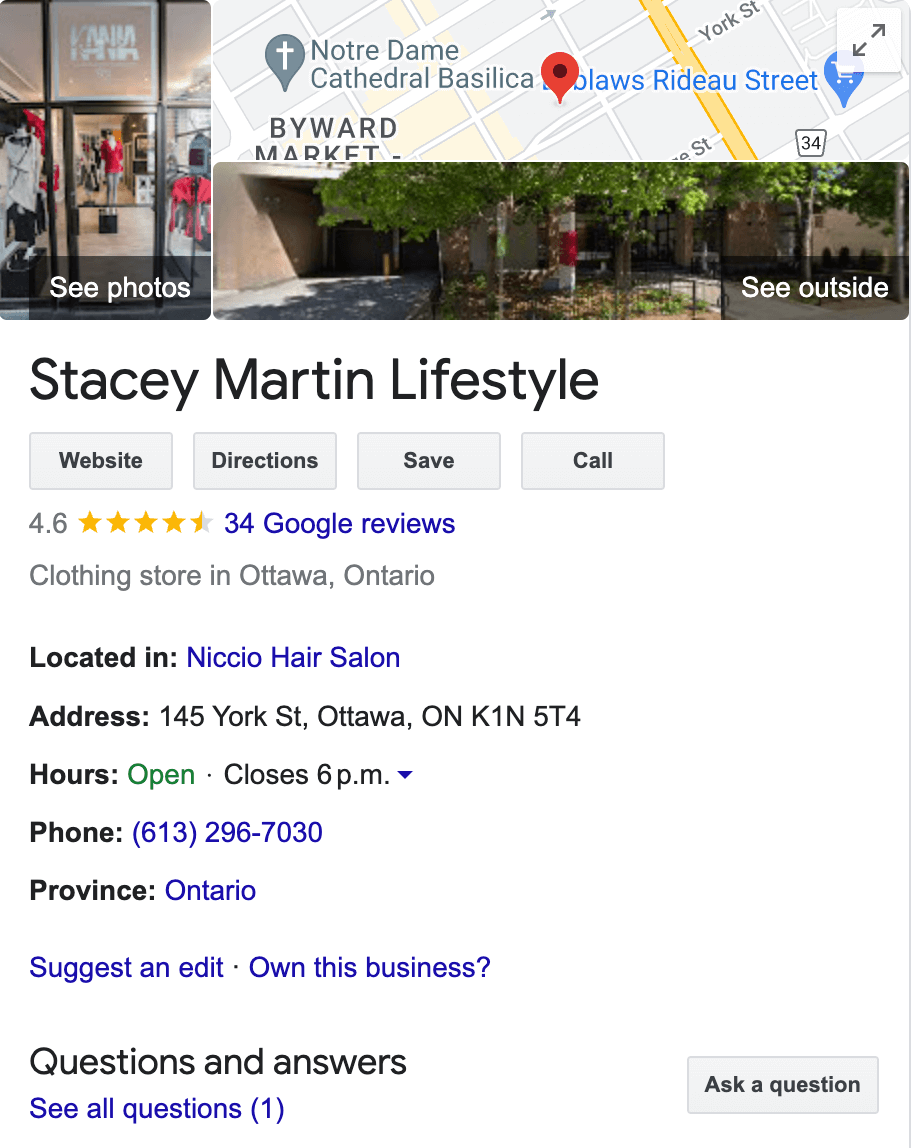
If you don’t have a physical location, you can still register a Google Business profile without indicating a street address.
Social Media
Social media profiles will also have backlinks to your website. This is a good source of traffic – by posting items your store sells on your social profiles, you can link potential customers directly to your store. Bringing in more potential customers overtime will also help to increase your ranking overall.
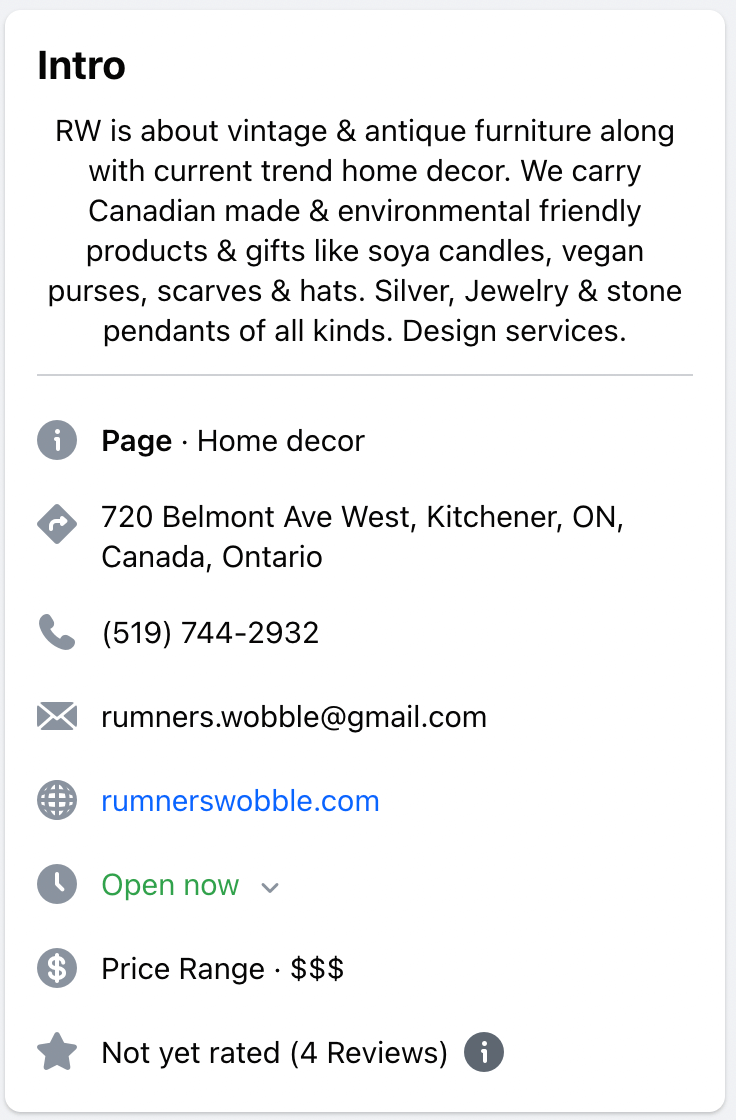
Reasons to implement SEO optimization
There are many reasons why every store owner should spend a little time on Shopify SEO optimization. I’ll go over some of the top reasons below:
On-Site SEO
Rank Higher and Attract More Customers
Improving on-site SEO on Shopify will make your website more findable. By optimizing content, structure, and performance, search engines can easily index and rank your site. A higher ranking means more people will find your site, attracting more customers to the store.
Target Better, More Ideal Customers
Focused keywords and targeted URL structure will help you find more of your best, ideal customers. For example if you sell different kinds of orthopedic products, and you know custom foot orthotics are your most profitable item, you can optimize these product pages to show up for more searches related to custom foot orthotics.
Or if you sell niche items like protective shoe covers that are worn by people attending outdoor music festivals, then you can update your title tags with keywords that will attract this very specific customer.
Fix Issues that Hamper Your SEO
While Shopify store setup comes with some useful things for SEO, much of its automation can create SEO issues such as duplicate content.
For example, Shopify does a lot for you in the background to set you up with basic title tags, but the ability to customize this allows you to make them more targeted for your ideal customers.
Customizing your store’s on-site SEO helps to eliminate any duplicated URLs from internal linking architecture and duplicate paginated URLs, compress images, and develop better, more relevant content.
Off-Site SEO
Rank Even Higher and Attract Even More Customers
Off-site SEO boosts your site’s authority and relevance through backlinks from other websites, directories, and social media profiles. This improves your website’s rankings. A higher ranking means more people will find your site, attracting more customers to the store.
Reach New Customers Outside of Search Engines
There are plenty of potential customers on social media and other websites who might not be on Google. Off-site SEO helps you connect to them.
This also opens up the opportunity to work with influencers who can promote your business on their content, social media posts and videos, Overall this creates a snowball effect with more backlinks and more traffic generally coming to your website.
Long-term Results
Off-site SEO strategies tend to go for the long haul. Unlike on-site SEO tactics that may require constant updates and changes, a strong off-site SEO profile can continue to drive traffic and improve search rankings over time.
How to implement Shopify SEO optimization
The best place to start is to work on on-site SEO. On-site SEO is crucial because it lays the foundation for your overall SEO strategy. By optimizing what you can directly on your website, you improve the experience for site visitors and increase your chances to rank higher in search results.
You are able to customize your SEO natively, but you’ll need to know how to do this on your own within Shopify. Shopify offers a library of guides to help you do this, but you’ll need to put in the time to learn how to do it.
The easiest and fastest way to improve your on-site SEO is with a Shopify app. There are many apps on the Shopify app store that streamline and automate the optimization process.
To find the best apps for Shopify store owners to improve their on-site SEO, I compared the top apps available on the Shopify app store.
SEO Doctor is the best app to quickly fix and improve your on-site SEO. With this app, you will fix issues with a guided checklist and track your progress with a dynamic overall SEO score. Without any technical knowledge you can manage key SEO elements such as meta tags, title tags, and URL structures efficiently.
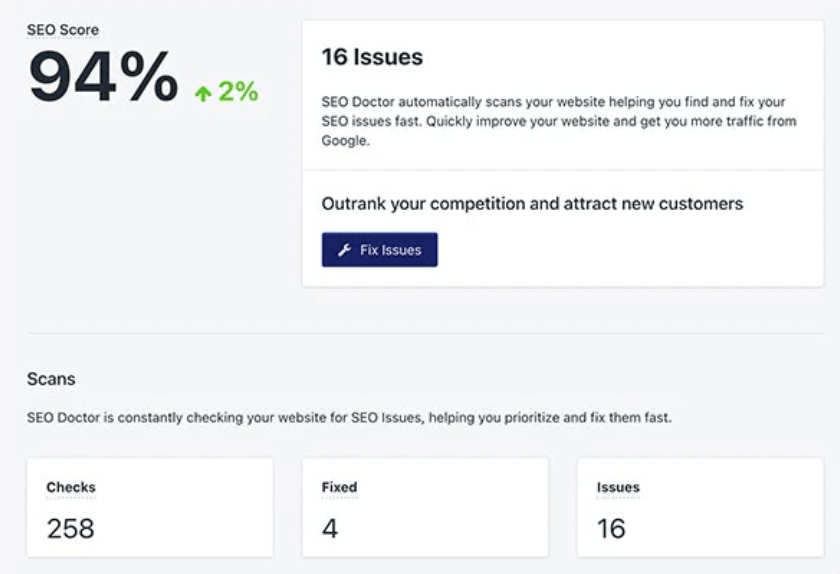
If you’re a busy merchant, you’ll also love the Autopilot feature which will improve on-site SEO for you as you update your website in the future. So you can sit back, relax, and watch your Shopify store’s website visitors increase over time.
Further Reading
SEO Doctor
Use the SEO Doctor for Search Engines app for access SEO tools to audit and optimize your store on autopilot. Improve your search ranking and sell more.
